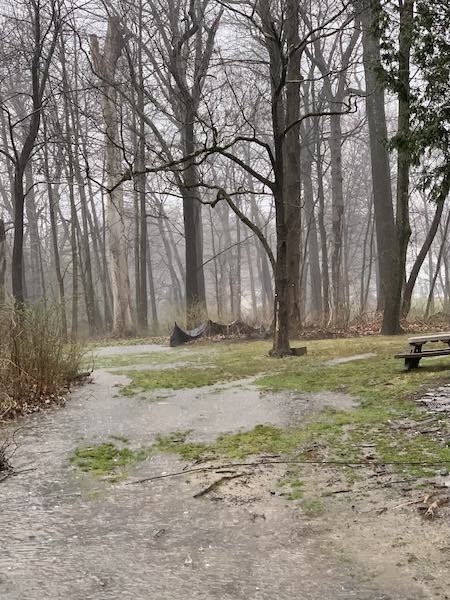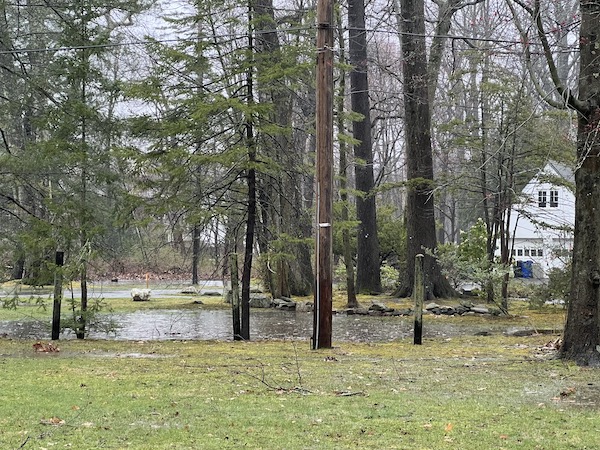Letters: Destruction of the Ecosystem is Exacerbating Flooding
- Category: On Our Radar
- Published: Monday, 25 March 2024 08:30
- Joanne Wallenstein
 80 Garden Road March 23, 2024(This letter was written by Madelaine Eppenstein and sent to the Mayor of Scarsdale and the Board of Trustees.)
80 Garden Road March 23, 2024(This letter was written by Madelaine Eppenstein and sent to the Mayor of Scarsdale and the Board of Trustees.)
Dear Mayor Arest,
Regarding proposed “development” on Garden Road referenced on Scarsdale10583.com: the misguided idea that adding topsoil and hardscape retaining walls, clear cutting a forest of 400+ mature canopy trees, and diverting water elsewhere will solve the complicated issues related to building in inundated, saturated areas—whether or not they are designated wetlands—may also be violative of numerous Code provisions.
Some in Village government may not wish to appear opposed to such projects broadly. But the ongoing destruction of Village ecosystems, its tree canopy, and the little open space that’s left is already exacerbating flooding and overwhelming stormwater infrastructure. In this era of climate change, prioritizing construction of a few luxury homes while abandoning the rest will continue to have a negative impact on what should be by now established Village goals of environmental protection, conservation and sustainability.
A proposal decades ago to construct a major public facility somewhere in the Village, which would have included grading and fill in at least one wetland area possibly similar to the Garden Road proposal, was, appropriately, rejected. The context was the wetland buffer between SHS and the Library campus—Harwood Park—one of over half a dozen sites being considered for the project at that time. Instead, the NYSDEC-grant restoration project begun ten years ago by Friends of Scarsdale Parks in collaboration with the Village included planting (by community volunteers) over 1,000 native trees and shrubs that literally stopped flooding in that multi-acreage area, while the adjacent impervious concrete and gravel student parking lot regularly continues to flood downstream along the Fox Meadow Brook. 80 Garden Road March 23, 2024
80 Garden Road March 23, 2024
With respect to the proposal that hundreds of mature canopy trees could be sacrificed on Garden Road, cited in the Scarsdale Forum’s recent environmental protection report here are EPA data and other sources regarding the superior water uptake capability of canopy trees. An article that wasn’t cited in that report addresses the relatively poor absorption of grass compared with trees, another false claim asserted publicly by some Scarsdale developers. Also see this article.
Also questionable is the Garden Road landscaper-proponent’s statement to the Planning Board, as quoted in the media, that in ten years newly planted trees would reach maturity. Obviously that doesn’t include canopy trees that generally take many decades to reach maturity. So many of the trees that would be lost on Garden Road are large diameter heritage trees that took long periods of time to mature, reach their majestic size, and contribute their now substantial ecosystem benefits.
Coincidentally, yesterday there were many flooded roads in Scarsdale, and no doubt flooded basements following heavy showers. Hopefully the Planning Board and the Village will carefully consider avoiding the potential for additional negative environmental consequences for downstream residents and roads from proposed development on Garden Road.
Sincerely,
Madelaine Eppenstein,
Scarsdale Resident
(The following letter was written to the Scarsdale Planning Board by Barry Abramson of 98 Garden Road.)
 80 Garden Road March 24, 2024To The Scarsdale Planning Board
80 Garden Road March 24, 2024To The Scarsdale Planning Board
Re: The 80 Garden Road Proposed Project To Build New Houses
I have lived at 98 Garden Road since 1998. I urge you to reject this proposal in its entirety. Allowing this project to proceed would result in an environmental disaster for all of the direct neighboring houses on Garden Road and Cushman Road, as well as negatively impacting homes well-beyond the immediate area.
This is a flood-prone neighborhood. Many backyards, including mine, have a large amount of standing water after only a moderate rainfall. In my case, more than 25% of my yard has standing water that remains for several days after most rainfall events. Many of the homes on Garden and Cushman Roads have suffered from basement and garage flooding after major storms in recent years, despite having multiple sump pumps in operation.
This neighborhood has outdated infrastructure. The neighborhood has inadequate culverts and outdated watercourses. Last fall, Village Engineer Dave Goessel discussed necessary capital projects at a public meeting. He specifically cited the need for “Culvert upgrades and watercourse improvements for Garden, Cushman, Willow and Sheldrake Roads.”
The 80 Garden Road Proposed Project would destroy a valuable wetlands. A wetlands reduces flooding in surrounding areas. During a heavy storm, each acre of wetlands can absorb and retain 1 million gallons of water. That water is then gradually released naturally over the course of several days. The 7.6 acre site of the proposed project is a wetlands. The only way to build on a wetlands is to destroy the wetlands, which is exactly what the developer has detailed in the plans that were submitted.
This 7.6 acre wetlands has been largely untouched since the end of the last Ice Age. The original homes on the Garden Road side of the wetlands were all constructed between 1928 and 1930. Most of the homes on the Cushman Road side of the wetlands were built between 1928 and 1966. Despite rising real estate values over the last century, no developer has been able to build on this site, although many have tried, because it is not feasible to build on a large wetlands site.
The plan to destroy the wetlands requires dumping more than 2,500 truckloads of contaminated landfill. According to the developers filed plans, at least 2,500 truckloads of contaminated construction debris would be dumped on the site in order to raise it by approximately 4 feet. According to construction industry guidelines, “clean fill” typically includes contaminants such as corrosives, combustibles, radioactive substances, asbestos, naturally occurring arsenic, lead from lead pipe fragments and lead paint chips, and synthetic materials from manufacturing processes.
The developer wants (and needs) to build a dangerous retaining wall to hold back the 4 foot high man-made mesa. The contaminated landfill would not be able to stay in place unless the developer builds a retaining wall. That retaining wall is an environmental problem of its own, and it will eventually crack and fail miserably within a few years. The resulting landslides would bring contaminated fill into every adjoining backyard on Garden and Cushman Roads.
This proposed project benefits no one in Scarsdale. It only benefits the developers. It should be rejected in its entirety.
Yours truly,
Barry Abramson
98 Garden Road
bma1977@aol.com










